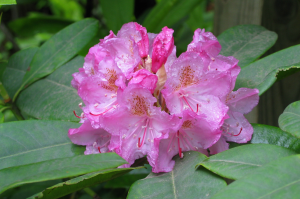Rhododendron macrophyllum
This has been the official flower of Washington State since 1892. Rhododendron macrophyllum was chosen in a state-wide vote only open to women before the 1893 Chicago World Fair. The leaves, flowers and nectar of this species can be toxic to humans and livestock. Honey made from the floral nectar has also been shown to be toxic.
Photo Credit: © Randy Smith via Wikimedia Commons
Rhododendron macrophyllum
Common Name: Pacific rhododendron
Plant Functional Group: Evergreen broadleaf
Class > Order > Family: Magnoliopsida > Ericales > Ericaceae
What does the species look like?
This species is a broadleaf evergreen shrub with grayish-brown bark that can be up to 4 meters tall. The thick leathery leaves are dark green and whorled at the tip of branches. Leaves have an elliptical shape and are 7 to 15 centimeters long by 3 to 7 centimeters wide. The bell shaped flowers are light to rose pink and 2 to 4 centimeters long. They are found in large loose clusters at the end of the branches. The fruit is a small brown five part capsule.
Rhododendron macrophyllum is found along Pacific coast, between Monterey County and British Columbia, in moist coniferous forests at elevations less than 1100 meters. It also thrives in disturbed habitats.
Where is the species found?
States & Provinces
BC, CA, OR, WA
Which phenophases should I observe?
Do you see...?
Leaves
Breaking leaf buds More...
How many buds are breaking?
Less than 3 3 to 10 11 to 100 101 to 1,000 1,001 to 10,000 More than 10,000
Young leaves How many young leaves are present?
Less than 3 3 to 10 11 to 100 101 to 1,000 1,001 to 10,000 More than 10,000
Flowers
Flowers or flower buds More...
How many flowers and flower buds are present? For species in which individual flowers are clustered in flower heads, spikes or catkins (inflorescences), simply estimate the number of flower heads, spikes or catkins and not the number of individual flowers.
Less than 3 3 to 10 11 to 100 101 to 1,000 1,001 to 10,000 More than 10,000
Open flowers More...
What percentage of all fresh flowers (buds plus unopened plus open) on the plant are open? For species in which individual flowers are clustered in flower heads, spikes or catkins (inflorescences), estimate the percentage of all individual flowers that are open.
Less than 5% 5-24% 25-49% 50-74% 75-94% 95% or more
Fruits
Fruits Rhododendron macrophyllum , the fruit is a woody capsule that changes from green to rusty brown and splits open to expose the seeds. Do not include empty capsules that have already dropped all of their seeds.More...
How many fruits are present?
Less than 3 3 to 10 11 to 100 101 to 1,000 1,001 to 10,000 More than 10,000
Ripe fruits Rhododendron macrophyllum , a fruit is considered ripe when it has turned rusty brown and has split open to expose the seeds. Do not include empty capsules that have already dropped all of their seeds.More...
What percentage of all fruits (unripe plus ripe) on the plant are ripe?
Less than 5% 5-24% 25-49% 50-74% 75-94% 95% or more
Recent fruit or seed drop More...
How many mature fruits have dropped seeds or have completely dropped or been removed from the plant since your last visit?
Less than 3 3 to 10 11 to 100 101 to 1,000 1,001 to 10,000 More than 10,000
What do these phenophases look like?
There is currently no photoguide available for this species. If you'd like help us create one, use the guidance document and species template provided here . Then send it via email to education@usanpn.org when it is complete.
